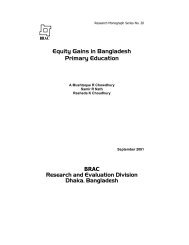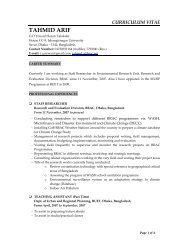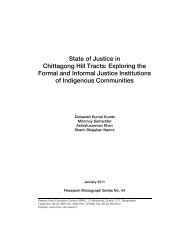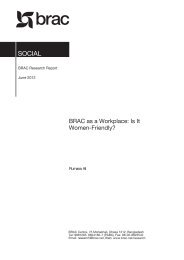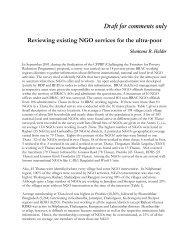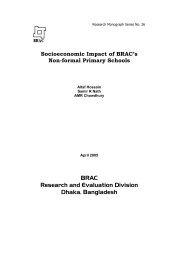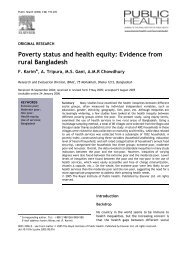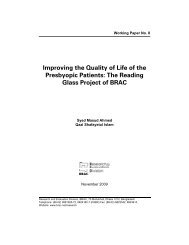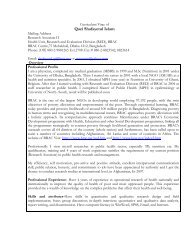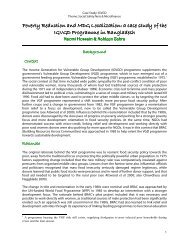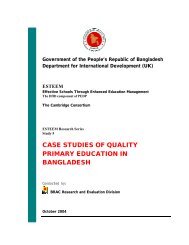Combining health and social protection measures to reach the ultra ...
Combining health and social protection measures to reach the ultra ...
Combining health and social protection measures to reach the ultra ...
You also want an ePaper? Increase the reach of your titles
YUMPU automatically turns print PDFs into web optimized ePapers that Google loves.
Decision-making<br />
Inequities in <strong>health</strong> status:<br />
findings from <strong>the</strong> 2001 Global<br />
Burden of Disease study<br />
Article by Alan Lopez (pictured) <strong>and</strong> Colin Ma<strong>the</strong>rs<br />
The 1990 Global Burden of Disease (GBD) study<br />
developed a comprehensive framework for integrating,<br />
validating, analyzing, <strong>and</strong> disseminating fragmented<br />
information on <strong>the</strong> <strong>health</strong> of populations so that it is truly<br />
useful for <strong>health</strong> policy <strong>and</strong> planning 7 . Features of this<br />
framework included <strong>the</strong> incorporation of data on nonfatal<br />
<strong>health</strong> outcomes in<strong>to</strong> summary <strong>measures</strong> of population<br />
<strong>health</strong> (described in <strong>the</strong> next subsection), <strong>the</strong> development of<br />
methods <strong>and</strong> approaches <strong>to</strong> estimate missing data <strong>and</strong> <strong>to</strong><br />
assess <strong>the</strong> reliability of data, <strong>and</strong> <strong>the</strong> use of a common metric<br />
<strong>to</strong> summarize <strong>the</strong> disease burden both from diagnostic<br />
categories of <strong>the</strong> international classification of diseases (ICD)<br />
<strong>and</strong> <strong>the</strong> major risk fac<strong>to</strong>rs that cause those <strong>health</strong> outcomes.<br />
The basic philosophy guiding <strong>the</strong> burden of disease<br />
approach is that almost all sources of <strong>health</strong> data are likely <strong>to</strong><br />
have information content provided that <strong>the</strong>y are carefully<br />
screened for plausibility <strong>and</strong> completeness <strong>and</strong> that internally<br />
consistent estimates of <strong>the</strong> global descriptive epidemiology of<br />
major conditions are possible with appropriate <strong>to</strong>ols,<br />
investiga<strong>to</strong>r commitment, <strong>and</strong> expert opinion. This<br />
philosophy remains central <strong>to</strong> <strong>the</strong> GBD 2001 study, which<br />
has exp<strong>and</strong>ed <strong>the</strong> framework of <strong>the</strong> original GBD study <strong>to</strong>:<br />
✜ quantify <strong>the</strong> burden of premature mortality <strong>and</strong> disability<br />
by age, sex, <strong>and</strong> region for 135 major causes or groups<br />
of causes;<br />
✜ develop internally consistent estimates of incidence,<br />
prevalence, duration, <strong>and</strong> case fatality rates for more<br />
than 500 sequelae resulting from <strong>the</strong> foregoing causes;<br />
✜ analyze <strong>the</strong> contribution <strong>to</strong> this burden of major<br />
physiological, behavioural, <strong>and</strong> <strong>social</strong> risk fac<strong>to</strong>rs by age,<br />
sex, <strong>and</strong> region.<br />
Estimating mortality: methods <strong>and</strong> data<br />
Complete death registration data cover only one third of <strong>the</strong><br />
world’s population. Some information on ano<strong>the</strong>r third is<br />
available through <strong>the</strong> national sample registration systems<br />
<strong>and</strong> urban death registration systems of India <strong>and</strong> China. For<br />
<strong>the</strong> remaining one third of <strong>the</strong> world’s population, including<br />
most countries in sub-Saharan Africa, only partial information<br />
is available from epidemiological studies, disease registers,<br />
<strong>and</strong> surveillance systems.<br />
To estimate <strong>the</strong> number of deaths by cause we drew on <strong>the</strong><br />
following four broad sources of data:<br />
✜ Death registration systems. Complete or incomplete<br />
death registration systems provide information about<br />
causes of death for almost all high-income countries<br />
<strong>and</strong> for many countries in Europe (Eastern) <strong>and</strong> Central<br />
Asia <strong>and</strong> in Latin America <strong>and</strong> <strong>the</strong> Caribbean. Some<br />
vital registration information is also available in all<br />
o<strong>the</strong>r regions.<br />
✜ Sample death registration systems. In China <strong>and</strong> India,<br />
sample registration systems for rural areas supplement<br />
urban death registration systems. Information systems<br />
now provide information on causes of death for several<br />
o<strong>the</strong>r large countries for which information was not<br />
available at <strong>the</strong> time of <strong>the</strong> original GBD study.<br />
✜ Epidemiological assessments. Epidemiologists have<br />
estimated deaths for specific causes, such as HIV/AIDS,<br />
malaria, <strong>and</strong> tuberculosis (TB), for most countries in <strong>the</strong><br />
regions most affected. These estimates usually combine<br />
information from surveys on <strong>the</strong> incidence or prevalence<br />
of <strong>the</strong> disease with data on case fatality rates.<br />
✜ Cause of death models. The cause of death models used<br />
in <strong>the</strong> original GBD study 7 were substantially revised <strong>and</strong><br />
enhanced for estimating deaths by broad cause group in<br />
regions with limited information on mortality. The<br />
CodMod software developed for this study <strong>and</strong> described<br />
later drew on a data set of 1613 country-years of<br />
observation of cause of death distributions from 58<br />
countries between 1950 <strong>and</strong> 2001.<br />
For <strong>the</strong> GBD 2001 study, age- <strong>and</strong> sex-specific death rates<br />
were calculated from <strong>the</strong> death <strong>and</strong> population data provided<br />
by countries, with adjustments made for completeness of <strong>the</strong><br />
registration data where needed, <strong>and</strong> <strong>the</strong>n <strong>to</strong>tal deaths by age<br />
<strong>and</strong> sex were calculated for each country by applying <strong>the</strong>se<br />
rates <strong>to</strong> <strong>the</strong> United Nations Population Division estimates of<br />
de fac<strong>to</strong> populations for 2001.<br />
Four methods were used <strong>to</strong> construct life tables for each<br />
country depending on <strong>the</strong> type of data available 2 :<br />
✜ Countries with death registration data for 2001. Such<br />
data were used directly <strong>to</strong> construct life tables for 56<br />
countries after adjusting for incomplete registration if<br />
necessary.<br />
✜ Countries with a time series of death registration data.<br />
Where <strong>the</strong> latest year of death registration data available<br />
Global Forum Update on Research for Health Volume 4 ✜ 163



